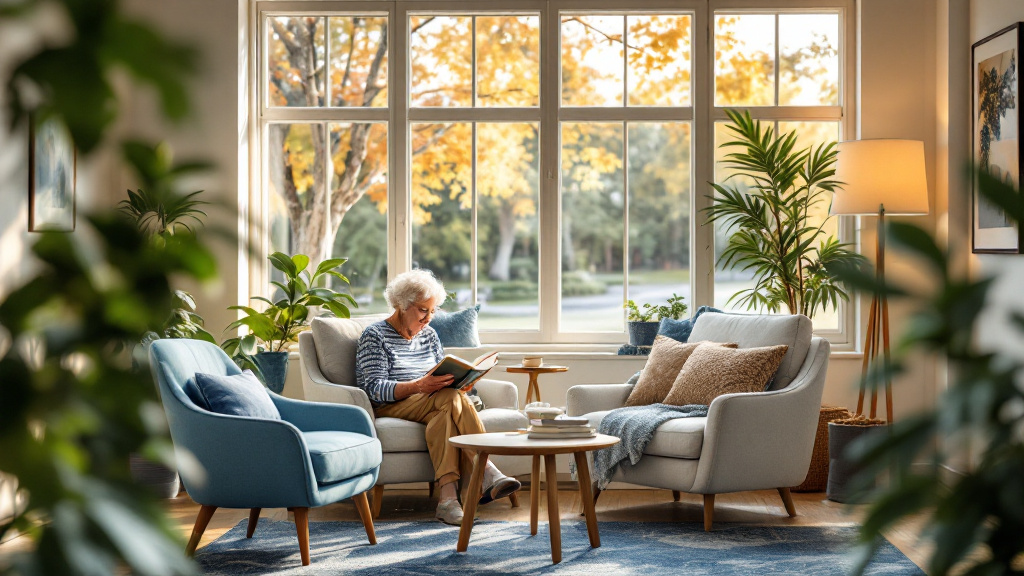
Technology for Assisted Living Facilities
March 4, 2025
Revolutionize assisted living with cutting-edge technology! Discover how facilities harness the power of AI, IoT, and telemedicine for better care.
Advancements in Assisted Living Technology

As technology continues to evolve, it has made significant advancements in the field of assisted living, enhancing the care provided to seniors. This section will explore the evolution of assisted living technology and the impact it has had on senior care.
Evolution of Assisted Living Technology
Assisted living technology has come a long way, revolutionizing the way care is delivered to seniors. In the past, traditional analog systems were used for communication and security purposes in assisted living facilities. However, these systems had limitations and were often prone to issues.
The Crest of Clemmons, an assisted living facility in Clemmons, NC, upgraded to the Tek-CARE®120 system by TekTone® after their legacy analog system was damaged by a lightning strike [1]. This upgrade showcases the shift towards modern technology solutions to meet the changing needs of assisted living facilities.
Today, technology plays a crucial role in delivering quality care and ensuring the safety and well-being of residents. From advanced communication systems to personalized health monitoring, the evolution of assisted living technology has transformed the way care is provided.
Impact of Technology on Senior Care
The impact of technology on senior care in assisted living facilities is immense. Artificial intelligence (AI) is increasingly being utilized to monitor residents, detect health issues, and prevent emergencies. AI systems track residents' normal behaviors, alert caregivers and family members in case of issues, and provide companionship and assistance through companion robots and wearable devices [2]. This personalized care through AI technology ensures that residents receive the attention they need while maintaining their independence.
The Internet of Things (IoT) is another technological advancement that has made a significant impact on senior care. By transforming ordinary objects into sources of valuable data, the IoT enhances security, well-being, and comfort in assisted living facilities. IoT devices can monitor residents' movements, detect falls, and automate tasks to promote a safer and more comfortable living environment [3].
Telemedicine has revolutionized healthcare in assisted living facilities by providing quick access to medical professionals and real-time monitoring of resident health data. This technology eliminates the need for frequent hospital visits, saving both time and money while ensuring residents receive timely medical attention [3].
Wearable devices have also become an integral part of senior care in assisted living. These devices monitor vital health information, detect falls, and provide continuous real-time health monitoring. With features such as GPS capabilities, wearable devices offer added security and promote a sense of freedom for residents while ensuring their well-being [3].
The integration of electronic health records (EHR) in assisted living facilities provides caregivers with a consistent overview of residents' care needs and helps monitor their activities of daily living. EHR integration streamlines documentation, enhances communication between healthcare providers, and ensures that residents receive the necessary care and support [3].
As technology continues to advance, the possibilities for improving senior care in assisted living facilities are endless. These advancements in assisted living technology have transformed the way care is delivered, enhancing the lives of seniors and providing peace of mind to their families and caregivers.
Artificial Intelligence in Assisted Living Facilities
As technology continues to advance, it is revolutionizing the way assisted living facilities operate, providing improved care and support for residents. One of the key technologies making a significant impact in this space is Artificial Intelligence (AI). AI enables personalized care through various applications, including predictive analytics for health risks and monitoring residents' behaviors.
Personalized Care through AI
Artificial Intelligence plays a vital role in the personalization of care in assisted living facilities. By analyzing residents' behavior, movement patterns, and health data, AI systems can gather valuable insights to tailor care plans specifically to each individual's needs. This personalized approach enhances the overall well-being and quality of life for residents.
AI systems can track residents' normal behaviors, including sleep patterns, eating habits, and mobility. By establishing a baseline for each resident, any deviations from the norm can be detected. This enables early intervention and timely assistance when necessary, preventing potential health issues or emergencies. Caregivers and family members can be alerted automatically, ensuring prompt and appropriate action.
Furthermore, AI technology can provide companionship and assistance through companion robots and wearable devices. Companion robots can engage with residents, offering social interaction, reminders for medication or appointments, and even entertainment. Wearable devices equipped with AI capabilities can monitor vital signs, such as heart rate and blood pressure, ensuring continuous health tracking and early detection of any abnormalities.
Predictive Analytics for Health Risks
Predictive analytics is a powerful application of AI in assisted living facilities. By leveraging the vast amount of data collected from residents, AI algorithms can identify patterns and trends that may indicate potential health risks. These algorithms can analyze data from various sources, including electronic health records, wearable devices, and IoT sensors, to identify patterns that may not be easily recognizable to human caregivers.
Through predictive analytics, AI systems can forecast the likelihood of falls, detect changes in health conditions, and predict potential risks to residents' well-being. Caregivers can then take proactive measures to prevent accidents or emergency situations. By utilizing AI technology, assisted living facilities can provide a safer environment for their residents.
The integration of AI in assisted living facilities is transforming the way care is delivered. It enables personalized care plans based on individual needs and provides predictive insights to prevent health risks. As the population of older adults increases, AI technology will continue to play a crucial role in supporting caregivers and enhancing the quality of care in assisted living facilities.
To learn more about the advancements in technology for assisted living facilities, continue reading about the benefits of Internet of Things (IoT) and Telemedicine.
Internet of Things (IoT) in Assisted Living
The Internet of Things (IoT) has revolutionized various industries, and assisted living facilities are no exception. By harnessing IoT technology, these facilities can enhance resident well-being, improve security, and provide a more comfortable living environment.
Enhancing Resident Well-being
In assisted living facilities, the IoT can transform ordinary objects into valuable sources of data, enabling caregivers to better understand and meet the needs of residents. For example, real-time location sensors can be used to track residents' locations without invasive cameras, allowing caregivers to monitor activities and whereabouts, which is particularly beneficial for those prone to wandering [4]. This technology helps ensure that residents are safe and accounted for at all times.
Furthermore, the IoT enables the integration of various health monitoring devices and systems. Wearable devices equipped with sensors can track vital information such as heart rate, blood pressure, and activity levels, providing valuable insights into residents' health status. This information can be transmitted in real-time to caregivers or healthcare professionals, enabling timely interventions and personalized care plans.
Security and Comfort in Facilities
The IoT also plays a crucial role in improving security and comfort within assisted living facilities. Smart home automation systems, integrated with IoT technology, allow for remote monitoring and control of various aspects, such as lighting, temperature, and door locks. This enables caregivers to create a safe and comfortable living environment for residents while optimizing energy efficiency.
Additionally, IoT-enabled devices can enhance safety measures within the facility. For instance, fall detection systems can automatically alert caregivers when a resident experiences a fall, ensuring prompt assistance. Anti-slip footwear, grab bars, and other assistive technologies can also be integrated into the IoT ecosystem to reduce the risk of falls and injuries [5].
By implementing IoT technology, assisted living facilities can leverage data-driven insights to improve the well-being of residents. The ability to monitor residents in real-time, enhance security measures, and create a comfortable living environment contributes to a higher quality of care and a better overall experience for residents.
As technology continues to advance, assisted living facilities can explore and adopt additional IoT solutions tailored to their specific needs. By embracing the opportunities offered by the IoT, these facilities can continue to revolutionize the way they provide care and support to their residents.
Telemedicine Benefits in Assisted Living
As technology continues to advance, it has made significant contributions to the field of assisted living, enhancing the quality of care provided to residents. One of the key technological advancements in assisted living facilities is telemedicine. This section will explore the benefits of telemedicine in assisted living, including quick access to medical professionals and real-time monitoring of health data.
Quick Access to Medical Professionals
Telemedicine allows residents in assisted living facilities to have quick and convenient access to medical professionals. Through video conferencing and remote consultations, residents can connect with doctors, nurses, and specialists without the need for in-person visits. This is particularly beneficial for residents with limited mobility or those living in rural areas where access to healthcare professionals may be challenging.
By utilizing telemedicine, residents can receive medical advice, discuss symptoms, and even receive prescriptions remotely. This not only saves time and effort but also reduces the need for transportation to hospitals or clinics. The ability to consult with medical professionals virtually ensures that residents can receive timely and appropriate care, leading to better health outcomes.
Real-time Monitoring for Health Data
Another significant advantage of telemedicine in assisted living facilities is the ability to monitor resident health data in real-time. With the help of wearable devices and remote monitoring systems, healthcare providers can track vital signs, such as heart rate, blood pressure, and oxygen levels, from a distance. This allows for proactive management of chronic conditions and early detection of any concerning health changes.
Real-time monitoring systems provide caregivers with valuable insights into residents' health status, enabling them to intervene promptly if any issues arise. For example, if there is a sudden change in heart rate or a significant drop in oxygen levels, caregivers can be alerted immediately, ensuring a rapid response and potentially preventing serious health complications.
By leveraging telemedicine, assisted living facilities can optimize healthcare delivery, providing efficient access to medical professionals and enabling proactive monitoring of resident health. These benefits contribute to enhanced overall care and improved quality of life for residents. As technology continues to evolve, telemedicine is likely to play an increasingly vital role in the future of assisted living.
Wearable Devices for Health Monitoring
In the realm of assisted living, wearable devices have emerged as a valuable tool for health monitoring. These devices offer a range of features that promote the well-being and safety of residents. Two key areas where wearable devices excel are vital information monitoring and fall detection with emergency alerts.
Vital Information Monitoring
Wearable devices equipped with sensors and advanced technology play a crucial role in monitoring vital health information for residents in assisted living facilities. These devices, such as smartwatches, can track various health metrics, including heart rate, blood pressure, oxygen saturation levels, and sleep patterns. By continuously monitoring these vital signs, caregivers and healthcare professionals can gain valuable insights into the overall health and well-being of residents.
Continuous monitoring of vital information allows for prompt detection of any abnormalities or changes in health, enabling early intervention and timely medical attention. This proactive approach can lead to better management of chronic conditions, timely detection of potential health risks, and improved overall health outcomes for residents.
Fall Detection and Emergency Alerts
One of the primary concerns in assisted living facilities is the risk of falls among residents. Wearable devices with fall detection capabilities provide an added layer of security and peace of mind for both residents and caregivers. These devices utilize built-in sensors and algorithms to detect sudden changes in motion and acceleration associated with a fall.
When a fall is detected, the wearable device can automatically send an alert to designated caregivers or staff members. This prompt notification allows for immediate assistance, minimizing the time between a fall and receiving help. Additionally, some wearable devices come equipped with emergency call capabilities, enabling residents to request assistance with a simple touch of a button.
By incorporating wearable devices for fall detection and emergency alerts, assisted living facilities can enhance resident safety and provide a swift response to potentially critical situations.
It's important to note that wearable devices for health monitoring should be selected with consideration for the specific needs and preferences of residents. The devices should be comfortable to wear, easy to use, and designed with the necessary features to support the unique requirements of assisted living environments.
In conclusion, wearable devices have revolutionized health monitoring in assisted living facilities. These devices enable continuous tracking of vital information and timely detection of potential health risks. Additionally, they provide an extra layer of security through fall detection capabilities and emergency alerts. By leveraging the power of wearable technology, assisted living facilities can enhance resident care, promote safety, and improve overall well-being.
Electronic Health Records (EHR) Integration
In the realm of assisted living, technology plays a vital role in improving the quality of care provided to residents. One such advancement is the integration of Electronic Health Records (EHR) in assisted living facilities. EHR systems help maintain a reliable and comprehensive record of residents' care, including their Activities of Daily Living (ADLs), vital signs, and medical information. This integration ensures a consistent overview of their care and enhances the overall efficiency of the facility.
Consistent Care Overview
With EHR integration, assisted living facilities can keep track of each resident's care in a centralized database. This comprehensive overview allows caregivers and medical professionals to access and update important information, such as medication schedules, allergies, and medical history. By having a consistent record of care, different staff members can collaborate effectively, ensuring that residents receive the appropriate and personalized care they need. The integration of EHR systems also helps eliminate the potential for errors or miscommunication that can occur with paper-based records.
Activities of Daily Living Monitoring
Monitoring and tracking residents' Activities of Daily Living (ADLs) are crucial in assisted living facilities. ADLs refer to the essential daily activities that individuals must perform to maintain their independence and well-being. This includes tasks such as bathing, dressing, eating, and mobility. By integrating EHR systems, staff members can accurately document and track residents' ADLs. This information helps caregivers identify any changes or decline in a resident's ability to perform these activities, allowing for early intervention and appropriate care adjustments.
Having a digital record of ADLs also enables staff members to identify patterns and trends in residents' daily routines. This information can be used to create personalized care plans and ensure that residents receive the necessary support to maintain their independence and overall well-being.
By integrating Electronic Health Records (EHR) systems, assisted living facilities can streamline their operations, improve communication among staff members, and enhance the quality of care provided to residents. The consistent care overview and accurate monitoring of Activities of Daily Living (ADLs) offered by EHR systems contribute to a more efficient and person-centered approach to assisted living.
References
[1]: https://leadingage.org/safety-technology-case-studies/
[2]: https://www.getgrooven.com/11-ways-technology-solutions-can-enhance-assisted-living-facilities/
[3]: https://arkenea.com/blog/assisted-living-technologies/
[4]: https://www.truelinkfinancial.com/blog/8-technologies-that-are-improving-care-in-long-term-care-facilities
[5]: http://aspe.hhs.gov/reports/barriers-implementing-technology-residential-long-term-care-settings-1



































































































